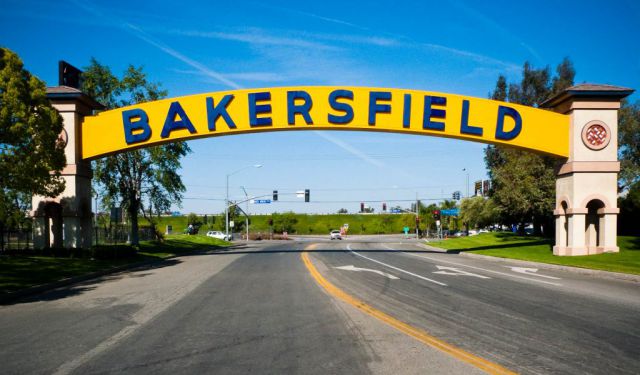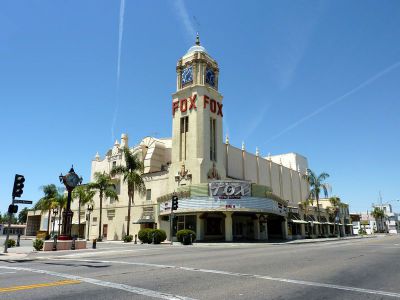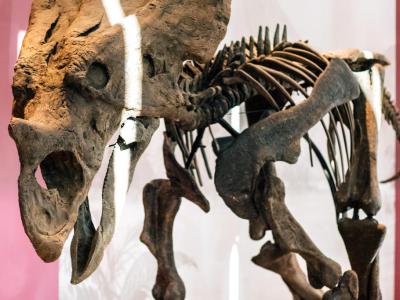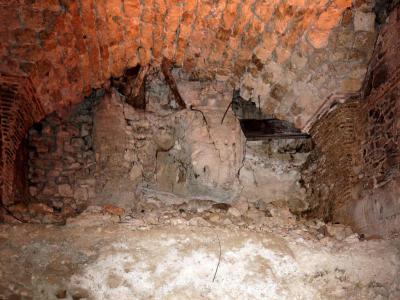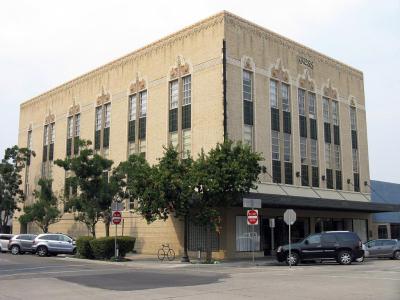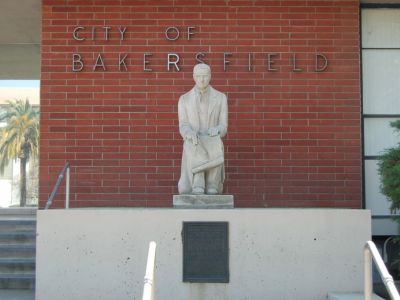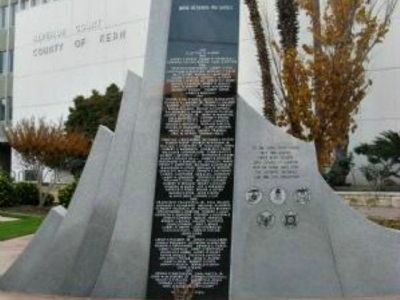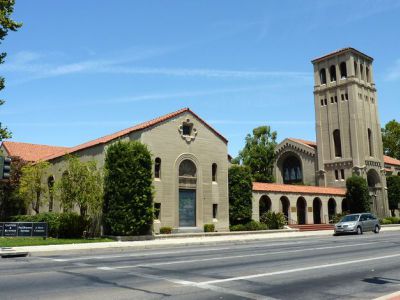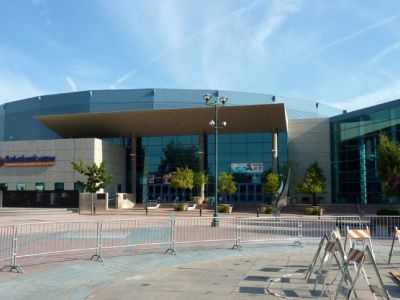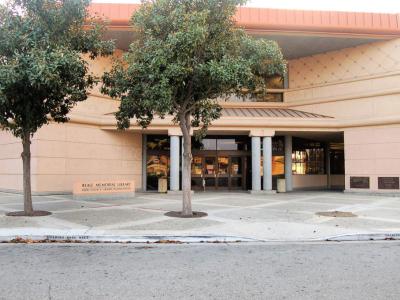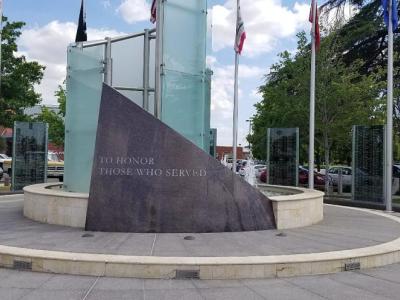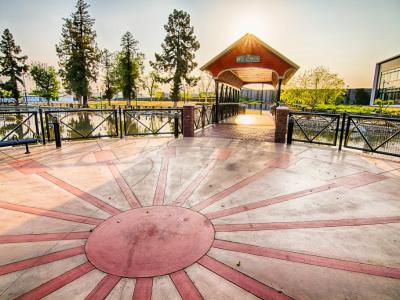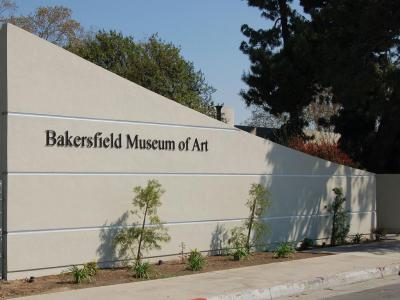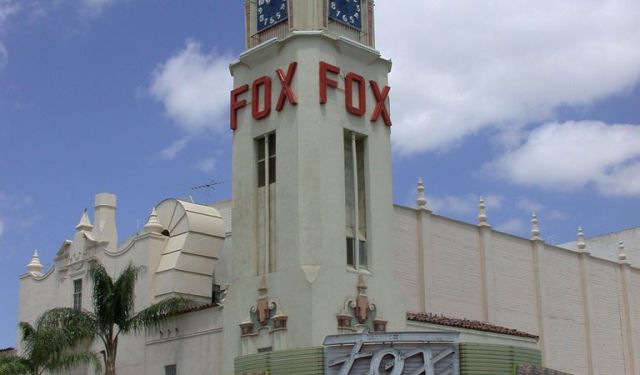Bakersfield Introduction Walking Tour (Self Guided), Bakersfield
Bakersfield, California is a hub of culture and history tucked away in the southern end of the San Joaquin Valley. Native Americans, specifically the Yokuts people, inhabited present-day Bakersfield for thousands of years. In 1776, Spanish missionary Francisco Garcés was the first European to explore this territory, encountering its indigenous population.
Among those attracted to the area by the California gold rush was Colonel Thomas Baker, who settled there in 1863. Famed for his hospitable nature, Baker created a stopover for travelers where they could rest their horses, which eventually came to be known as "Baker's Field." This hospitable spirit remains a cornerstone of the city’s identity even today.
Between 1970 and 2010, Bakersfield's population grew 400%, making it one of the fastest-growing cities in California. Its close proximity to mountain passes has made Bakersfield a regional transportation hub.
Despite a devastating 5.8 quake that struck the city on August 22, 1952, damaging many of local structures, downtown Bakersfield is still home to a variety of notable historical and cultural landmarks reflecting its heritage.
Prime amongst them is the Fox Theater, a 1930 architectural gem that continues to host performances, offering a glimpse into the city's vibrant entertainment past. Nearby, the Buena Vista Museum of Natural History provides an educational experience with exhibits ranging from paleontology to anthropology, emphasizing the natural history of the Kern County region.
For antique lovers and history enthusiasts, the Merry Go Round Antique Mall offers a plethora of vintage finds and houses fascinating underground tunnels, adding a touch of mystery to the shopping experience. Another notable site, the Kress Building, represents the early 20th-century commercial style and contributes to the architectural diversity of the downtown area.
The historical significance of Bakersfield is further highlighted by landmarks such as the FW Woolworth Company Store Historical Marker, which commemorates the site of one of America’s iconic five-and-dime stores. Just a short walk away stands the City Hall, adorned with the Colonel Thomas Baker Statue, honoring the city’s founder.
Indeed, Bakersfield is a city that honors its past while actively shaping its future. Anyone attracted by historical sites, cultural landmarks, or the warmth of the local community is cordially invited to Bakersfield to explore and engage with its unique heritage. Take this self-guided tour and discover the stories that make up the fabric of this lovely city, and be inspired by the legacy of its people and places.
Among those attracted to the area by the California gold rush was Colonel Thomas Baker, who settled there in 1863. Famed for his hospitable nature, Baker created a stopover for travelers where they could rest their horses, which eventually came to be known as "Baker's Field." This hospitable spirit remains a cornerstone of the city’s identity even today.
Between 1970 and 2010, Bakersfield's population grew 400%, making it one of the fastest-growing cities in California. Its close proximity to mountain passes has made Bakersfield a regional transportation hub.
Despite a devastating 5.8 quake that struck the city on August 22, 1952, damaging many of local structures, downtown Bakersfield is still home to a variety of notable historical and cultural landmarks reflecting its heritage.
Prime amongst them is the Fox Theater, a 1930 architectural gem that continues to host performances, offering a glimpse into the city's vibrant entertainment past. Nearby, the Buena Vista Museum of Natural History provides an educational experience with exhibits ranging from paleontology to anthropology, emphasizing the natural history of the Kern County region.
For antique lovers and history enthusiasts, the Merry Go Round Antique Mall offers a plethora of vintage finds and houses fascinating underground tunnels, adding a touch of mystery to the shopping experience. Another notable site, the Kress Building, represents the early 20th-century commercial style and contributes to the architectural diversity of the downtown area.
The historical significance of Bakersfield is further highlighted by landmarks such as the FW Woolworth Company Store Historical Marker, which commemorates the site of one of America’s iconic five-and-dime stores. Just a short walk away stands the City Hall, adorned with the Colonel Thomas Baker Statue, honoring the city’s founder.
Indeed, Bakersfield is a city that honors its past while actively shaping its future. Anyone attracted by historical sites, cultural landmarks, or the warmth of the local community is cordially invited to Bakersfield to explore and engage with its unique heritage. Take this self-guided tour and discover the stories that make up the fabric of this lovely city, and be inspired by the legacy of its people and places.
How it works: Download the app "GPSmyCity: Walks in 1K+ Cities" from Apple App Store or Google Play Store to your mobile phone or tablet. The app turns your mobile device into a personal tour guide and its built-in GPS navigation functions guide you from one tour stop to next. The app works offline, so no data plan is needed when traveling abroad.
Bakersfield Introduction Walking Tour Map
Guide Name: Bakersfield Introduction Walking Tour
Guide Location: USA » Bakersfield (See other walking tours in Bakersfield)
Guide Type: Self-guided Walking Tour (Sightseeing)
# of Attractions: 13
Tour Duration: 2 Hour(s)
Travel Distance: 3.1 Km or 1.9 Miles
Author: DanaOffice
Sight(s) Featured in This Guide:
Guide Location: USA » Bakersfield (See other walking tours in Bakersfield)
Guide Type: Self-guided Walking Tour (Sightseeing)
# of Attractions: 13
Tour Duration: 2 Hour(s)
Travel Distance: 3.1 Km or 1.9 Miles
Author: DanaOffice
Sight(s) Featured in This Guide:
- Fox Theater
- Buena Vista Museum of Natural History
- Merry Go Round Antique Mall and Tunnels
- Kress Building
- F.W. Woolworth Company Store Historical Marker
- City Hall and Colonel Thomas Baker Statue
- Kern County Vietnam War Memorial
- First Baptist Church
- Rabobank Arena, Theater, and Convention Center
- Beale Memorial Library
- Kern Veterans Memorial
- Central Park at Mill Creek
- Bakersfield Museum of Art
1) Fox Theater (must see)
The Fox Theater has been a central hub for performing arts since it opened on Christmas Day in 1930. Renowned for its architectural charm and cultural significance, the theater has hosted a wide array of performances, from ballets to contemporary pop and rock acts, making it a vibrant fixture in Bakersfield's arts and entertainment scene.
The Fox Theater's inaugural feature was "Just Imagine," a science fiction film set 50 years in the future. The 1930s marked a golden era for the theater, with its screen showcasing the latest "talkie" films and its stage graced by notable performers. These included Metropolitan Opera baritone Lawrence Tibbett, soprano Kirsten Flagstad, the Los Angeles Philharmonic Orchestra, and pianist Arthur Rubinstein. The theater's robust Type I construction, consisting of poured concrete over steel, enabled it to withstand the devastating 1952 earthquake that leveled many buildings in Bakersfield, further cementing its legacy as a resilient and enduring cultural landmark.
Today, the Fox Theater remains the heart of Downtown Bakersfield's arts and entertainment district. It is home to FLICS, Bakersfield's acclaimed foreign film program, which runs annually from fall through spring and features the best foreign films of the past year. The theater continues to attract a variety of music stars, such as Cyndi Lauper, Olivia Newton-John, and Switchfoot, while also hosting local dance recitals and performing arts events, including the Russian ballet. This diverse programming ensures that the Fox Theater remains a beloved venue for both residents and visitors, celebrating the richness of Bakersfield's cultural heritage.
The Fox Theater's inaugural feature was "Just Imagine," a science fiction film set 50 years in the future. The 1930s marked a golden era for the theater, with its screen showcasing the latest "talkie" films and its stage graced by notable performers. These included Metropolitan Opera baritone Lawrence Tibbett, soprano Kirsten Flagstad, the Los Angeles Philharmonic Orchestra, and pianist Arthur Rubinstein. The theater's robust Type I construction, consisting of poured concrete over steel, enabled it to withstand the devastating 1952 earthquake that leveled many buildings in Bakersfield, further cementing its legacy as a resilient and enduring cultural landmark.
Today, the Fox Theater remains the heart of Downtown Bakersfield's arts and entertainment district. It is home to FLICS, Bakersfield's acclaimed foreign film program, which runs annually from fall through spring and features the best foreign films of the past year. The theater continues to attract a variety of music stars, such as Cyndi Lauper, Olivia Newton-John, and Switchfoot, while also hosting local dance recitals and performing arts events, including the Russian ballet. This diverse programming ensures that the Fox Theater remains a beloved venue for both residents and visitors, celebrating the richness of Bakersfield's cultural heritage.
2) Buena Vista Museum of Natural History
The Buena Vista Museum of Natural History, located in the Arts District of downtown Bakersfield, is a captivating institution dedicated to the fields of geology, anthropology, and paleontology. Founded in 1995, the museum has become a cornerstone of educational and cultural enrichment in the region, offering visitors a glimpse into the natural history of Kern County and beyond.
The museum's origins are deeply intertwined with the Bob and Mary Ernst Collection of Miocene fossils from Shark Tooth Hill, one of the largest collections of its kind. Initially, the museum operated out of a small space within the California Living Museum (CALM). As the collection grew, so did the museum's need for more space, prompting several relocations until it settled in its current downtown location. This growth allowed the museum to expand its exhibits and educational outreach, attracting a diverse array of visitors.
Central to the museum's allure is the Mary Ernst Collection of Miocene fossils from Shark Tooth Hill, showcasing a rich array of specimens that transport visitors back millions of years. In addition to this impressive collection, the museum boasts a variety of other exhibits, including a collection of taxidermy animals from Africa, a replica of a triceratops skull, a detailed replica of a Yokuts Indian village, and a meticulously crafted model of Yosemite Valley, complete with roads, buildings, and trails. These exhibits provide a comprehensive look at both local and global natural history.
The museum's origins are deeply intertwined with the Bob and Mary Ernst Collection of Miocene fossils from Shark Tooth Hill, one of the largest collections of its kind. Initially, the museum operated out of a small space within the California Living Museum (CALM). As the collection grew, so did the museum's need for more space, prompting several relocations until it settled in its current downtown location. This growth allowed the museum to expand its exhibits and educational outreach, attracting a diverse array of visitors.
Central to the museum's allure is the Mary Ernst Collection of Miocene fossils from Shark Tooth Hill, showcasing a rich array of specimens that transport visitors back millions of years. In addition to this impressive collection, the museum boasts a variety of other exhibits, including a collection of taxidermy animals from Africa, a replica of a triceratops skull, a detailed replica of a Yokuts Indian village, and a meticulously crafted model of Yosemite Valley, complete with roads, buildings, and trails. These exhibits provide a comprehensive look at both local and global natural history.
3) Merry Go Round Antique Mall and Tunnels
The Merry Go Round Antique Mall offers more than just a collection of vintage treasures; it serves as a portal to the city's intriguing underground past. Beneath this quaint antique store lies a network of tunnels, a remnant from the early 1900s that hints at Bakersfield's storied history. Visitors peering through a basement window can glimpse an old brick enclosure that forms part of this subterranean labyrinth, which reflects a bygone era of the city’s development. These tunnels, although newer than the original ones built in the 1880s, have become an integral part of the lore surrounding Bakersfield’s hidden depths.
The history of Bakersfield's tunnels is deeply intertwined with the city's unique position as the only California county to host multiple China Towns. These enclaves emerged in the mid-1880s, populated by Chinese immigrants who came from different parts of China and spoke various dialects, leading to the formation of distinct communities just streets apart. To escape the sweltering Bakersfield heat, these communities constructed tunnels. However, the tunnels beneath Merry Go Round Antiques were constructed after the devastating Bakersfield fire of 1889 and were primarily intended for the transportation of goods.
Contrary to popular myths, the tunnels were not used for nefarious activities such as transporting drugs and alcohol. Although tales of underground gambling and opium dens persist, these are largely fictional. Such activities did occur in the China Towns, but they were not hidden away underground; instead, they took place openly within the communities. Additionally, there is no credible evidence to support the notion that the tunnels were ever haunted, despite the rich folklore that surrounds them.
Today, the tunnels under Merry Go Round Antiques offer a unique glimpse into the past, revealing the practical and social dynamics of the city’s early immigrant communities. For both tourists and locals, exploring these tunnels provides a fascinating connection to the historical fabric of Bakersfield, enriching their understanding of the city's cultural heritage.
The history of Bakersfield's tunnels is deeply intertwined with the city's unique position as the only California county to host multiple China Towns. These enclaves emerged in the mid-1880s, populated by Chinese immigrants who came from different parts of China and spoke various dialects, leading to the formation of distinct communities just streets apart. To escape the sweltering Bakersfield heat, these communities constructed tunnels. However, the tunnels beneath Merry Go Round Antiques were constructed after the devastating Bakersfield fire of 1889 and were primarily intended for the transportation of goods.
Contrary to popular myths, the tunnels were not used for nefarious activities such as transporting drugs and alcohol. Although tales of underground gambling and opium dens persist, these are largely fictional. Such activities did occur in the China Towns, but they were not hidden away underground; instead, they took place openly within the communities. Additionally, there is no credible evidence to support the notion that the tunnels were ever haunted, despite the rich folklore that surrounds them.
Today, the tunnels under Merry Go Round Antiques offer a unique glimpse into the past, revealing the practical and social dynamics of the city’s early immigrant communities. For both tourists and locals, exploring these tunnels provides a fascinating connection to the historical fabric of Bakersfield, enriching their understanding of the city's cultural heritage.
4) Kress Building
The Kress Building is an exemplary piece of Art Deco architecture, constructed in 1931 using reinforced steel and brick. Designed by the renowned American architect Edward Sibbert, the building originally housed a Kress Department Store, part of the national Kress & Co. chain known for its five-and-dime stores. Samuel Kress, the company's founder, was notable for commissioning talented architects to create distinctive buildings, making Kress stores recognizable and aesthetically appealing fixtures in cities across the United States.
The Kress department store in Bakersfield operated until 1974, after which the building was closed. However, recognizing its architectural and historical significance, efforts were made to preserve and renovate the structure. By 1984, the building had been successfully repurposed as office space, retaining its historic charm while adapting to new uses.
In 2015, the Kern County Historical Society placed a historical marker to the right of the building's entrance, commemorating its rich history and significance. This marker highlights the building's legacy as a part of the Kress & Co. chain and its importance to the architectural and cultural heritage of Bakersfield.
The Kress department store in Bakersfield operated until 1974, after which the building was closed. However, recognizing its architectural and historical significance, efforts were made to preserve and renovate the structure. By 1984, the building had been successfully repurposed as office space, retaining its historic charm while adapting to new uses.
In 2015, the Kern County Historical Society placed a historical marker to the right of the building's entrance, commemorating its rich history and significance. This marker highlights the building's legacy as a part of the Kress & Co. chain and its importance to the architectural and cultural heritage of Bakersfield.
5) F.W. Woolworth Company Store Historical Marker
The F.W. Woolworth Company Store Historical Marker commemorates the arrival of Woolworth's retail presence in the city as early as 1911. Woolworth's, renowned for its chain of five-and-dime stores, profoundly influenced the commercial landscape of the early 20th century. This successful chain extended across the United States, Britain, and Canada, becoming a household name that provided a wide variety of affordable goods to the public. The historical marker in Bakersfield not only highlights the store's significance in the local community but also acknowledges its broader impact on retail history. The exterior of the building features the classic F.W. Woolworth Company signage, adding to its historical charm.
One of Woolworth's most beloved features was its diner-style luncheonette counter, which became a popular gathering spot for shoppers. These counters offered classic American meals at reasonable prices, creating a unique and enjoyable shopping experience. The Bakersfield Woolworth's store was no exception, and its luncheonette counter became a cherished part of the community's social fabric.
Despite its popularity, the F.W. Woolworth Company eventually succumbed to increasing competition from emerging retail giants and changing market dynamics. By 1997, all Woolworth's retail stores had closed.
Today, the first floor of the historic Woolworth's building resembles a puzzle, with relics from the past scattered throughout: old signs, vinyl chairs, industrial steel siding, and giant mirrors covered in construction dust. Despite the clutter, the building's significance is immediately apparent, highlighted by the absence of its marquee attraction-the last Woolworth’s lunch counter in the U.S., which has been deconstructed. This iconic feature is now in the process of careful refurbishment, awaiting documentation and alignment with the building's original plans before being reassembled.
One of Woolworth's most beloved features was its diner-style luncheonette counter, which became a popular gathering spot for shoppers. These counters offered classic American meals at reasonable prices, creating a unique and enjoyable shopping experience. The Bakersfield Woolworth's store was no exception, and its luncheonette counter became a cherished part of the community's social fabric.
Despite its popularity, the F.W. Woolworth Company eventually succumbed to increasing competition from emerging retail giants and changing market dynamics. By 1997, all Woolworth's retail stores had closed.
Today, the first floor of the historic Woolworth's building resembles a puzzle, with relics from the past scattered throughout: old signs, vinyl chairs, industrial steel siding, and giant mirrors covered in construction dust. Despite the clutter, the building's significance is immediately apparent, highlighted by the absence of its marquee attraction-the last Woolworth’s lunch counter in the U.S., which has been deconstructed. This iconic feature is now in the process of careful refurbishment, awaiting documentation and alignment with the building's original plans before being reassembled.
6) City Hall and Colonel Thomas Baker Statue
Bakersfield City Hall serves as the epicenter of government for the City of Bakersfield. The current City Hall, completed in 1954, replaced the original structure that was destroyed by the devastating 1952 Kern County earthquake. This building houses the Mayor's office and the City Council chambers, playing a crucial role in the city's administrative and political activities.
Prominently positioned in front of City Hall is a statue of Colonel Thomas Baker, the city's founder, designated as a California Historical Landmark. Erected in 1944, this statue is a significant symbol of Bakersfield's heritage. It portrays Colonel Baker seated and holding a document, symbolizing his role as an intellectual and pioneer. The statue is not only a tribute to his contributions but also a reminder of the city's rich history and its roots in the pioneering spirit of its early settlers.
Colonel Thomas Baker, after whom Bakersfield is named, was a notable figure in American history. He served as an officer in the Revolutionary War and later became an adventurer and pioneer. He first settled in the area around 1863, bringing with him a vision that would eventually shape the future of Bakersfield. His legacy is preserved not only in the city's name but also through this statue, which stands as a testament to his enduring impact on the community.
Prominently positioned in front of City Hall is a statue of Colonel Thomas Baker, the city's founder, designated as a California Historical Landmark. Erected in 1944, this statue is a significant symbol of Bakersfield's heritage. It portrays Colonel Baker seated and holding a document, symbolizing his role as an intellectual and pioneer. The statue is not only a tribute to his contributions but also a reminder of the city's rich history and its roots in the pioneering spirit of its early settlers.
Colonel Thomas Baker, after whom Bakersfield is named, was a notable figure in American history. He served as an officer in the Revolutionary War and later became an adventurer and pioneer. He first settled in the area around 1863, bringing with him a vision that would eventually shape the future of Bakersfield. His legacy is preserved not only in the city's name but also through this statue, which stands as a testament to his enduring impact on the community.
7) Kern County Vietnam War Memorial
The Kern County Vietnam War Memorial stands as a poignant tribute to the local heroes who sacrificed their lives during the Vietnam War. Located in front of the Kern County Superior Court, this memorial is a place of reflection and reverence. Its design features a central black rectangular block, solemnly inscribed with the names of Kern County residents who perished in the conflict, ensuring that their bravery and sacrifice are forever remembered.
Flanking the central block are two lighter-colored wing-shaped stones, which add a striking contrast to the memorial. This thoughtful design not only enhances the visual appeal but also symbolizes the wings of a guardian, perhaps representing the protection and honor bestowed upon the fallen soldiers. The stark contrast between the black block and the lighter wings highlights the gravity of the loss and the enduring respect for those who served.
The Kern County Vietnam War Memorial is more than just a list of names; it is a beautifully crafted tribute that encapsulates the community's gratitude and reverence for its veterans. The careful placement in front of the Superior Court adds a layer of significance, connecting the themes of justice and sacrifice.
Flanking the central block are two lighter-colored wing-shaped stones, which add a striking contrast to the memorial. This thoughtful design not only enhances the visual appeal but also symbolizes the wings of a guardian, perhaps representing the protection and honor bestowed upon the fallen soldiers. The stark contrast between the black block and the lighter wings highlights the gravity of the loss and the enduring respect for those who served.
The Kern County Vietnam War Memorial is more than just a list of names; it is a beautifully crafted tribute that encapsulates the community's gratitude and reverence for its veterans. The careful placement in front of the Superior Court adds a layer of significance, connecting the themes of justice and sacrifice.
8) First Baptist Church
The First Baptist Church, affectionately known as the Bell Towers, stands as a testament to Bakersfield's rich architectural and religious heritage. Constructed in 1931, this historic church complex, now repurposed as an office building, holds a prominent place in the community's history. Its architectural significance led to its inclusion on the National Register of Historic Places on January 2, 1979, ensuring its preservation for future generations.
Built with reinforced concrete and adorned with Spanish tile shingles, the First Baptist Church exudes timeless charm and elegance. The exterior finish, crafted to simulate brick through poured casting, adds to its visual appeal. At the heart of the complex rises a majestic 70-foot bell tower, a striking feature that once formed part of the church's vestibule and narthex. The south facade, adorned with large white oak doors and decorative arches, welcomes visitors with warmth and grace, reflecting the church's inviting spirit.
The architectural elements of the First Baptist Church showcase a blend of Romanesque and Mission Revival styles, adding depth and character to its design. The intricate details, such as blind arches, mullions, and lofty arched windows, contribute to its unique aesthetic. The original fellowship hall, situated on the southwest side, embodies the Mission Revival style with its grand arched windows and ornate doorways, creating a serene and tranquil atmosphere within its walls. Surrounded by a landscaped courtyard and connected by a single-story arcade, the church complex offers a sanctuary of peace and tranquility in the heart of Bakersfield.
Built with reinforced concrete and adorned with Spanish tile shingles, the First Baptist Church exudes timeless charm and elegance. The exterior finish, crafted to simulate brick through poured casting, adds to its visual appeal. At the heart of the complex rises a majestic 70-foot bell tower, a striking feature that once formed part of the church's vestibule and narthex. The south facade, adorned with large white oak doors and decorative arches, welcomes visitors with warmth and grace, reflecting the church's inviting spirit.
The architectural elements of the First Baptist Church showcase a blend of Romanesque and Mission Revival styles, adding depth and character to its design. The intricate details, such as blind arches, mullions, and lofty arched windows, contribute to its unique aesthetic. The original fellowship hall, situated on the southwest side, embodies the Mission Revival style with its grand arched windows and ornate doorways, creating a serene and tranquil atmosphere within its walls. Surrounded by a landscaped courtyard and connected by a single-story arcade, the church complex offers a sanctuary of peace and tranquility in the heart of Bakersfield.
9) Rabobank Arena, Theater, and Convention Center
The Rabobank Theater and Convention Center stands as a cultural and entertainment hub in the vibrant city of Bakersfield, California. Originally known as the Civic Auditorium, this iconic venue was constructed in 1962 with the aim of attracting the convention trade to the city. From its inception, the auditorium hosted a diverse array of events, including the inaugural Ice Capades show on November 20, 1962. Renowned for its modern architectural style, the facility boasted one of the largest stages in the world, setting the stage for captivating performances and unforgettable experiences.
Over the years, the Civic Auditorium underwent significant expansions and renovations to meet the evolving needs of the community. In 1976, plans were set in motion for a major expansion project, which included the construction of a convention center and an adjacent hotel. This transformation marked a new era for the venue, now known as the Bakersfield Convention Center, as it expanded its offerings to accommodate a wider range of events and gatherings.
In 1998, the facility underwent another transformation with the construction of a state-of-the-art sports arena, capable of seating up to 10,000 spectators. This expansion, coupled with the removal of the adjacent parking lot, paved the way for the creation of the Centennial Garden and Convention Center. This integrated complex not only enhanced the city's entertainment landscape but also provided a seamless experience for visitors, with the convention center serving as a staging ground for events held in the arena. Seven years later, the entire complex was renamed the Rabobank Arena, Theater, and Convention Center, reflecting its multifaceted offerings and status as a premier destination for entertainment and gatherings in Bakersfield.
Over the years, the Civic Auditorium underwent significant expansions and renovations to meet the evolving needs of the community. In 1976, plans were set in motion for a major expansion project, which included the construction of a convention center and an adjacent hotel. This transformation marked a new era for the venue, now known as the Bakersfield Convention Center, as it expanded its offerings to accommodate a wider range of events and gatherings.
In 1998, the facility underwent another transformation with the construction of a state-of-the-art sports arena, capable of seating up to 10,000 spectators. This expansion, coupled with the removal of the adjacent parking lot, paved the way for the creation of the Centennial Garden and Convention Center. This integrated complex not only enhanced the city's entertainment landscape but also provided a seamless experience for visitors, with the convention center serving as a staging ground for events held in the arena. Seven years later, the entire complex was renamed the Rabobank Arena, Theater, and Convention Center, reflecting its multifaceted offerings and status as a premier destination for entertainment and gatherings in Bakersfield.
10) Beale Memorial Library
Beale Memorial Library stands as a testament to the enduring legacy of General Edward F. Beale and his family's commitment to education and public service. Established at the dawn of the 20th century, the library owes its existence to the generous contributions of the Beale family, who donated the building, furnishings, and several collections to the city in memory of General Beale. This philanthropic gesture laid the foundation for a cherished institution that would serve as a beacon of knowledge and learning for generations to come.
Despite facing adversity in the form of the devastating earthquake of 1952, which left the original library building in ruins, the spirit of Beale Memorial Library endured. In 1988, the library found a new home in a state-of-the-art, 130,000-square-foot facility located on Truxtun Avenue. This modern building not only provided a fresh start for the library but also symbolized the resilience and determination of the Bakersfield community to preserve its cultural heritage and intellectual resources.
Today, Beale Memorial Library stands as Kern County's central research library, offering a wealth of resources to scholars, researchers, and avid readers alike. With approximately 300,000 items in its collection, including an extensive archive of local history and genealogy records, the library serves as a vital hub for those seeking to explore the rich tapestry of Kern County's past and present.
Despite facing adversity in the form of the devastating earthquake of 1952, which left the original library building in ruins, the spirit of Beale Memorial Library endured. In 1988, the library found a new home in a state-of-the-art, 130,000-square-foot facility located on Truxtun Avenue. This modern building not only provided a fresh start for the library but also symbolized the resilience and determination of the Bakersfield community to preserve its cultural heritage and intellectual resources.
Today, Beale Memorial Library stands as Kern County's central research library, offering a wealth of resources to scholars, researchers, and avid readers alike. With approximately 300,000 items in its collection, including an extensive archive of local history and genealogy records, the library serves as a vital hub for those seeking to explore the rich tapestry of Kern County's past and present.
11) Kern Veterans Memorial
The Kern Veterans Memorial stands as a solemn tribute to the courageous men and women of Kern County who have answered the call to serve their nation in times of peace and war. Located in downtown Bakersfield, this monument serves as a poignant reminder of the sacrifices made by local residents in defense of freedom and democracy. Designed by John Cohrs, the memorial encompasses a circular plaza with two paths, symbolizing the journey of veterans as they navigate through life's challenges.
At the heart of the memorial lies a captivating fountain, adorned with granite and glass elements that spiral upward toward a central point. Inscribed with the poignant words "To honor all those who served," the granite pedestal serves as a poignant reminder of the selfless dedication exhibited by Kern County's veterans. Illuminated by lights that cast rotating colors of red, white, and blue, the fountain stands as a beacon of hope and remembrance, especially poignant against the backdrop of bustling Truxtun Avenue.
Surrounding the plaza, nine flags flutter in the breeze, representing the United States of America, the State of California, and the branches of the armed forces. Each flag serves as a symbol of pride and patriotism, honoring the commitment and sacrifice of servicemen and women across generations. Alongside the flags, the Wall of Valor pays tribute to those who made the ultimate sacrifice, their names etched in gold on glass panels.
At the heart of the memorial lies a captivating fountain, adorned with granite and glass elements that spiral upward toward a central point. Inscribed with the poignant words "To honor all those who served," the granite pedestal serves as a poignant reminder of the selfless dedication exhibited by Kern County's veterans. Illuminated by lights that cast rotating colors of red, white, and blue, the fountain stands as a beacon of hope and remembrance, especially poignant against the backdrop of bustling Truxtun Avenue.
Surrounding the plaza, nine flags flutter in the breeze, representing the United States of America, the State of California, and the branches of the armed forces. Each flag serves as a symbol of pride and patriotism, honoring the commitment and sacrifice of servicemen and women across generations. Alongside the flags, the Wall of Valor pays tribute to those who made the ultimate sacrifice, their names etched in gold on glass panels.
12) Central Park at Mill Creek
Central Park at Mill Creek offers a serene oasis in the heart of Bakersfield. Nestled alongside the picturesque Kern Island Canal, this park has been a beloved community gathering space since its establishment in 1937. Adjacent to the park, the Bakersfield Museum of Art and the Bakersfield Community House add to the cultural vibrancy of the area, making it a hub of activity and leisure for residents and visitors alike.
In 2009, local authorities embarked on a redevelopment project for Central Park at Mill Creek, aiming to enhance its amenities and create a more inviting recreational space. Spearheaded by Meyer Civil Engineering, this revitalization effort has transformed the park into a 1.5-acre haven for relaxation and outdoor enjoyment. Among its notable features is the New Mill Creek covered bridge, a charming architectural gem that adds character to the park's landscape. Concrete walkways meander through lush greenery, providing a tranquil setting for leisurely strolls and picnics, while decorative fountains add a touch of elegance to the surroundings.
Although construction continues to expand and improve the park, Central Park at Mill Creek remains a delightful destination for locals and tourists alike. As plans unfold to further develop the canal into a serene lake and introduce additional facilities, visitors can anticipate even more opportunities for recreation and leisure in this urban oasis. Whether seeking a peaceful retreat or a vibrant community space, Central Park at Mill Creek offers something for everyone to enjoy amidst the beauty of nature and the rich cultural heritage of Bakersfield.
In 2009, local authorities embarked on a redevelopment project for Central Park at Mill Creek, aiming to enhance its amenities and create a more inviting recreational space. Spearheaded by Meyer Civil Engineering, this revitalization effort has transformed the park into a 1.5-acre haven for relaxation and outdoor enjoyment. Among its notable features is the New Mill Creek covered bridge, a charming architectural gem that adds character to the park's landscape. Concrete walkways meander through lush greenery, providing a tranquil setting for leisurely strolls and picnics, while decorative fountains add a touch of elegance to the surroundings.
Although construction continues to expand and improve the park, Central Park at Mill Creek remains a delightful destination for locals and tourists alike. As plans unfold to further develop the canal into a serene lake and introduce additional facilities, visitors can anticipate even more opportunities for recreation and leisure in this urban oasis. Whether seeking a peaceful retreat or a vibrant community space, Central Park at Mill Creek offers something for everyone to enjoy amidst the beauty of nature and the rich cultural heritage of Bakersfield.
13) Bakersfield Museum of Art
Located within Central Park, the Bakersfield Museum of Art stands as a cultural beacon, showcasing the vibrant creativity of regional artists and offering a diverse array of visual arts experiences to the community. Established in 1956 by the Walter Osborn family, the museum was originally named the Cunningham Art Gallery in memory of their daughter, Marion Osborn Cunningham. Since its inception, the museum has been dedicated to fostering an appreciation for the arts through exhibitions, educational programs, community outreach, and special events.
Comprising four galleries spread across 17,400 square feet, the Bakersfield Museum of Art boasts a permanent collection featuring works primarily by regional artists. These galleries provide a platform for showcasing the rich tapestry of artistic talent present in the area, while also offering space for traveling art exhibits that bring diverse perspectives and artistic styles to the forefront. Accredited by the American Association of Museums in 1991, the museum has earned recognition for its commitment to excellence in curatorial practices and artistic engagement.
In addition to its galleries, the museum features two classrooms and a banquet hall, facilitating educational initiatives and community gatherings. Outside, lush gardens adorned with sculptures and other art forms enhance the museum's aesthetic appeal, providing visitors with an immersive artistic experience from the moment they arrive.
Comprising four galleries spread across 17,400 square feet, the Bakersfield Museum of Art boasts a permanent collection featuring works primarily by regional artists. These galleries provide a platform for showcasing the rich tapestry of artistic talent present in the area, while also offering space for traveling art exhibits that bring diverse perspectives and artistic styles to the forefront. Accredited by the American Association of Museums in 1991, the museum has earned recognition for its commitment to excellence in curatorial practices and artistic engagement.
In addition to its galleries, the museum features two classrooms and a banquet hall, facilitating educational initiatives and community gatherings. Outside, lush gardens adorned with sculptures and other art forms enhance the museum's aesthetic appeal, providing visitors with an immersive artistic experience from the moment they arrive.
Walking Tours in Bakersfield, California
Create Your Own Walk in Bakersfield
Creating your own self-guided walk in Bakersfield is easy and fun. Choose the city attractions that you want to see and a walk route map will be created just for you. You can even set your hotel as the start point of the walk.
Bakersfield Historical Buildings Tour
Although many buildings in Bakersfield, California were damaged during the earthquake of 1952, the majority of them have survived and since then been carefully restored and preserved. Thanks to this effort, the city boasts a rich tapestry of historical properties reflecting its growth and cultural heritage.
Among these landmarks, the Fox Theater stands out as a beacon of entertainment history.... view more
Tour Duration: 1 Hour(s)
Travel Distance: 1.2 Km or 0.7 Miles
Among these landmarks, the Fox Theater stands out as a beacon of entertainment history.... view more
Tour Duration: 1 Hour(s)
Travel Distance: 1.2 Km or 0.7 Miles
The Most Popular Cities
/ view all
